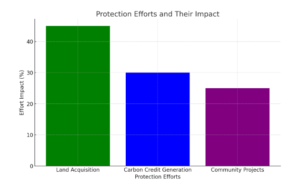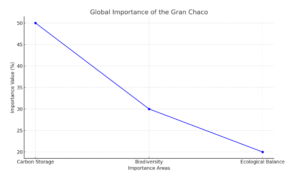In a world increasingly concerned with climate change and environmental preservation, the story of the Gran Chaco forest in Paraguay stands as a beacon of hope and an example of successful collaborative conservation. The Swiss Trust Trading Group (STTG) has played a pivotal role in transforming this once-threatened region into a thriving ecosystem through a strategic partnership with the Paraguayan government. This blog explores the journey from rampant deforestation to robust forest conservation, underscoring the critical importance of collaborative efforts in sustainable land management.
The Plight of the Gran Chaco
The Gran Chaco, sprawling across Paraguay, Bolivia, and Argentina, is one of South America’s largest forested regions, second only to the Amazon in biodiversity. Historically, this area has suffered from extensive deforestation due to logging and land clearing for agriculture, threatening its rich biodiversity and contributing to global carbon emissions. Recognizing the urgent need for intervention, STTG embarked on an ambitious project to halt the destruction and rehabilitate the land.
STTG’s Initiative and Government Collaboration
STTG’s conservation strategy involved direct collaboration with the Paraguayan government to implement sustainable land management practices. Central to this initiative was the development of a scalable investment model, as detailed in the “Final STTG – Chaco Forest Loan Note Instrument,” which facilitated the acquisition of land to be preserved and protected. By funding the purchase of the Chaco forest land at competitive prices, STTG not only safeguarded the area but also promoted environmental sustainability through responsible stewardship.
Investment in Conservation and Community Involvement
The partnership strategy included mobilizing substantial financial resources, with STTG offering high-yield, short-term Loan Note instruments to fund land purchases. Investors were given a unique opportunity to contribute to conservation efforts while earning a return on investment, thanks to the carbon credit offset values generated from preserved forest lands. This innovative financial instrument promised a 22% net return over 12 months, combining financial appeal with environmental impact.
Securing Long-Term Land Conservation
To ensure lasting protection of acquired lands, STTG collaborates with conservation-focused partners supported by leading corporations. These partnerships play a crucial role in managing protected areas, ensuring they remain undeveloped and continue functioning as vital carbon sinks.
By working with trusted conservation organizations with proven expertise, STTG guarantees that environmental goals are met through effective land management. This approach underscores the importance of aligning with reliable partners capable of overseeing large-scale conservation efforts, securing both environmental impact and long-term sustainability.
The Impact of Conservation Efforts
The results of these efforts have been profoundly positive. The conservation projects have not only helped preserve the biodiversity of the Gran Chaco but also contributed to the local and global environment by preventing further deforestation and enabling carbon sequestration. Moreover, these projects have provided social benefits by involving local communities in conservation efforts and sustainable economic activities, thus fostering a model of development that respects both ecological and human needs.
Expanding Conservation Efforts
According to a report by The Nature Conservancy, the Gran Chaco forest faces significant environmental pressures from deforestation primarily due to agricultural expansion. The Gran Chaco, spanning several South American countries, is critically important for its biodiversity, which includes numerous endemic species. Conservation efforts in the region are crucial not only for preserving biodiversity but also for maintaining the ecological balance necessary to support local communities and prevent further climate change impacts. These initiatives aim to implement sustainable land use practices that reconcile economic growth with environmental stewardship.
Collaborative Initiatives
As reported by BirdLife International, a comprehensive conservation strategy for the Gran Chaco involves multiple stakeholders, including local and international organizations, governments, and indigenous communities. This collaborative approach is vital in addressing the complex socio-economic and environmental challenges facing the region. By integrating biodiversity conservation with sustainable development goals, these partnerships work towards creating protected areas and promoting ecological agriculture that benefits both the environment and the indigenous populations who depend on the forest for their livelihoods.
Urgency and Global Impact
Mongabay highlights the global significance of the Gran Chaco as South America’s second-largest forest, which is now at risk of collapsing due to unchecked deforestation. This vast forested area plays a crucial role in carbon storage, making it a key player in global efforts to combat climate change. Protecting the Gran Chaco is not just a regional priority but a global imperative. Conservation efforts here can serve as a model for other regions facing similar threats, showcasing how proactive measures can effectively counteract the adverse effects of human activities on critical ecosystems.
Looking Forward: Sustainable Development and Global Lessons
The collaboration between STTG and the Paraguayan government serves as a model for other regions facing similar environmental challenges. It demonstrates the power of public-private partnerships in achieving large-scale environmental goals and the role of innovative financing in driving conservation efforts. As global awareness of environmental issues grows, the story of the Gran Chaco offers valuable lessons on integrating economic objectives with ecological sustainability.
Conclusion
The transformation of the Gran Chaco forest from a region marked by deforestation to one of preservation is a testament to the effectiveness of collaborative efforts between corporate entities like STTG and governmental bodies. This initiative not only highlights the critical role of sustainable land management practices but also sets a precedent for environmental conservation efforts worldwide, proving that with the right strategies and partnerships, significant positive environmental impacts are achievable.







STTG’s collaboration in Gran Chaco is a great example of sustainable conservation 🌍💚. Protecting forests, supporting communities! 🌱🌳